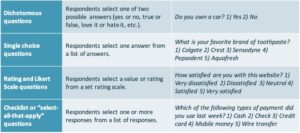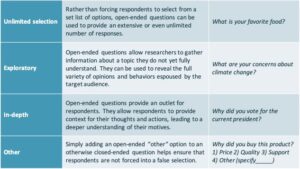- Contents
Survey development always starts with a simple question: what do we want to learn? Once a research question is formulated, researchers must decide the best ways to answer that question. They must determine both which survey questions to ask and how to ask them. While asking the right questions is important, asking questions the right way can be equally impactful on the overall quality of the data produced by the survey.
Survey questions can be divided into two distinct categories: closed-ended questions and open-ended questions. Deciding whether to use closed-ended questions, open-ended questions, or a combination of the two comprises a critical step in the survey development process. While designing a survey questionnaire, it is important to understand the benefits and limitations of each question type.
Closed-ended Survey Questions
In closed-ended survey questions, respondents select from a finite set of pre-defined responses. Common types of closed-ended survey questions include:

In each of the closed-ended question types above, respondents are not allowed to provide unique or unanticipated answers. Instead, they are asked to choose from a list of pre-defined options.
The narrow and structured focus of closed-ended survey questions provides quantitative research data that is quickly and easily measured. The data gathered from these questions forms the foundation of all statistical analysis applied to surveys. Because the quantitative analysis methodology is scientific and statistics-based, it yields data that is conclusive and projectable to a larger population.
The drawback of closed-ended questions is that respondents are limited to the responses offered by the researcher. Therefore, the researcher must have a clear understanding of the research topic before drafting the survey, not only to pose the right survey questions but to provide an applicable and comprehensive set of responses to choose from for each question. Without providing a complete and accurate list of survey responses, respondents may be forced to select the best available answer rather than the answer they would prefer, resulting in erroneous information and insights.
In addition to providing the right response options, researchers must also pay careful attention to the wording of each option, the number of options offered, and the order in which the options are read. Studies by Pew Research indicate that all four factors can influence how respondents answer closed-ended research questions.
To ensure that the results of a survey are both quantifiable and accurately reflect the target audience’s true thoughts and experiences, many surveys consist primarily of closed-ended questions that can be quickly analyzed, plus several open-ended questions that provide deeper insights into the topic being studied.
Open-ended Survey Questions
In open-ended survey questions, respondents are asked to reply to each question in their own words. The questions should be written purposefully not to lead the respondent in any particular direction, but rather to give them the freedom to provide unstructured and unguided feedback.
Some of the ways and reasons why open-ended questions are used in surveys include:

Open-ended survey questions provide qualitative research data. They elicit free-form candid responses that are only limited by respondents’ imagination and ability to express themselves.
Although open-ended questions provide deep insight into the feelings and thought processes of respondents, they are not as objective or easily quantifiable as closed-ended questions. Analyzing open-ended research questions requires the researcher to label and categorize responses to identify key themes and patterns – a process known as coding. Coding qualitative data can be significantly more time-consuming and laborious than analyzing quantitative data.
Most researchers find significant value in asking both closed-ended and open-ended survey questions. Understanding the differences between the two helps researchers ask the right questions in the right way to attain more accurate and actionable insights.
Conduct Surveys Around the World with GeoPoll
GeoPoll has experience administering surveys all over the world for clients ranging from global brands and international development organizations to local media stations and NGOs. Our solutions can be tailored to reach any audience via a variety of survey modes, including SMS, CATI, CAPI, mobile web, and our mobile application. We understand that every project is unique and are committed to using our expertise to guide our clients through key decisions to produce the most accurate insights possible. To learn more about GeoPoll’s research modes and data collection processes, please contact us here.
